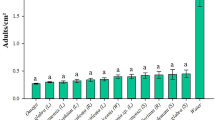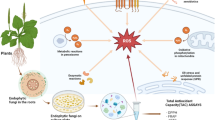Abstract
Larvae of the Asian corn borer Ostrinia furnacalis (Guenée) must cope with 2,4-dihydroxy-7-methoxy-1,4-benzoxazin-3-one (DIMBOA), a major toxic allelochemical present in its host plant, maize Zea mays L. UDP-glucosyltransferase (UGT), which conjugates glucose to various lipophilic toxic compounds and thereby makes them more hydrophilic for easier excretion, has been suggested to be involved in the detoxification of DIMBOA in several insects. Our previous in vitro assays using O. furnacalis midgut homogenates demonstrated that DIMBOA was catabolized only when UDP-glucose, a glucose donor for UGT activity, was included in the reaction mixture; however, DIMBOA glucoside, the expected product of UGT activity, was only detected in trace amounts in assay products. The present study revealed that DIMBOA glucoside was produced, but was immediately degraded by unidentified enzymes in the midgut homogenate that do not require UDP-glucose for their activities, suggesting the presence of a novel route for DIMBOA catabolism in O. furnacalis.



Similar content being viewed by others
References
Ahmad SA, Hopkins TL (1992) Phenol β-glucosyltransferase and β-glucosidase activities in the tobacco hornworm larva Manduca sexta (L.): properties and tissue localization. Arch Insect Biochem Physiol 224:207–224
Ahmad SA, Hopkins TL (1993) β-Glucosylation of plant phenolics by phenol β-glucosyltransferase in larval tissues of the tobacco hornworm, Manduca sexta (L.). Insect Biochem Mol Biol 23:581–589
Ahn SJ, Vogel H, Heckel DG (2012) Comparative analysis of the UDP-glycosyltransferase multigene family in insects. Insect Biochem Mol Biol 42:133–147
Atkinson J, Morand P, Arnason JT (1991) Analogues of the cyclic hydroxamic acid 2,4-dihydroxy-7-methoxy-2H-1,4-benzoxazin-3-one: decomposition to benzoxazolinones and reaction with beta-mercaptoethanol. J Org Chem 56:1788–1800
Ishikawa Y, Takanashi T, Kim CG, Hoshizaki S, Tatsuki S, Huang Y (1999) Ostrinia spp. in Japan: their host plants and sex pheromones. Entomol Exp Appl 91:237–244
Kojima W, Fujii T, Suwa M, Miyazawa M, Ishikawa Y (2010) Physiological adaptation of the Asian corn borer Ostrinia furnacalis to chemical defenses of its host plant, maize. J Insect Physiol 56:1349–1355
Meihls LN, Kaur H, Jander G (2012) Natural variation in maize defense against insect herbivores. Cold Spring Harb Symp Quant Biol 77:269–283
Mutuura A, Munroe E (1970) Taxonomy and distribution of the European corn borer and allied species: genus Ostrinia (Lepidoptera: Pyralidae). Mem Entomol Soc Can 102:1–112
Phuong TTT, Yamamoto M, Fujii T, Kojima W, Matsuo T, Ishikawa Y (2015) Comparison of the ability to catabolize DIMBOA, a maize antibiotic, between Ostrinia furnacalis and Ostrinia scapulalis (Lepidoptera: Crambidae), with reference to their hybrids. Appl Entomol Zool 51:143–149
Sasai H, Ishida M, Murakami K, Tadokoro N, Ishihara A, Nishida R, Mori N (2009) Species-specific glucosylation of DIMBOA in larvae of the rice armyworm. Biosci Biotechnol Biochem 73:1333–1338
Wouters FC, Reichelt M, Glauser G, Bauer E, Erb M, Gershenzon J, Vassão DG (2014) Reglucosylation of the benzoxazinoid DIMBOA with inversion of stereochemical configuration is a detoxification strategy in lepidopteran herbivores. Angew Chemie 126:11502–11506
Wouters FC, Blanchette B, Gershenzon J, Vassão DG (2016) Plant defense and herbivore counter-defense: benzoxazinoids and insect herbivores. Phytochem Rev 15:1127–1151
Acknowledgements
This work was supported by JSPS KAKENHI grant number 17H03776 to YI.
Author information
Authors and Affiliations
Corresponding author
Electronic supplementary material
Below is the link to the electronic supplementary material.
Rights and permissions
About this article
Cite this article
Phuong, T.T.T., Yamamoto, M., Matsuo, T. et al. In vitro analysis of DIMBOA catabolism in the Asian corn borer Ostrinia furnacalis (Lepidoptera: Crambidae). Appl Entomol Zool 53, 223–227 (2018). https://doi.org/10.1007/s13355-018-0547-y
Received:
Accepted:
Published:
Issue Date:
DOI: https://doi.org/10.1007/s13355-018-0547-y




